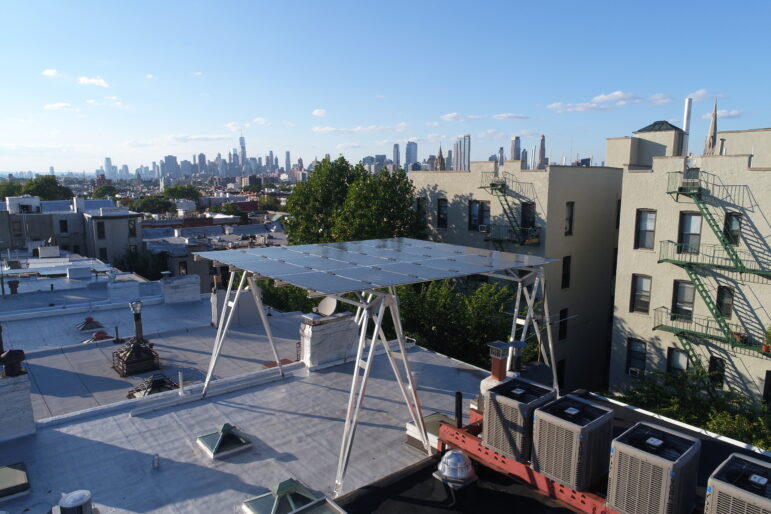City councilmembers introduced new legislation Thursday to change the city’s fire code and allow homeowners more space on their roofs to install solar panels.

Brooklyn Solar Works
A rooftop installation by Brooklyn Solar Works. The company elevates its solar panels to comply with spacing requirements in the city’s fire code.
City Council Members Thursday introduced a bill to ease regulations for the installation of solar panels, proposing a change to the fire department code that would decrease spacing requirements that impede their use on city rooftops.
The current code says rooftops must include a clear path of no less than six feet for big buildings and four feet for more compact ones. The bill aims to bring that clear-path requirement down to four feet for larger properties and three feet for smaller ones. The reduction still provides safe passage for firefighters to get through in case of an emergency, according to City Council members.
“We can safely expand solar on our rooftops and significantly advance our climate goals if we get the regulations streamlined and updated to make solar installation more readily available for New Yorkers,” Councilmember Lincoln Restler who is co-sponsoring the bill, told City Limits.
Under the proposed rules, neighbors will also be given the option to team up and adjoin their rooftops so that they may be consolidated, making it easier for building owners to comply with the spacing requirements.
“We have ambitious goals around solar implementation in New York City, but we are way behind in achieving them because government regulations keep getting in the way,” Restler added.
As of last year, the city has installed solar panels across 110 city-owned buildings, fulfilling only 16 percent of its de Blasio-era commitment to build 100 megawatts of solar capacity on public-owned rooftops by 2025.
When it comes to private residential properties, there are over 43,000 rooftop solar projects in New York City, according to the New York State Energy Research and Development Authority (NYSERDA). With over 1.6 billion square feet of rooftop space, New York City has enormous potential to bring more green energy into people’s homes and reduce greenhouse gas emissions.
But there are many barriers that keep people from switching to solar. For one, the commitment requires significant upfront investment: In 2022, the average residential solar system cost $30,374 before incentives, according to NYSERDA.
There are a series of private financing programs that allow people to take out loans, as well as government incentives that ease the burden for homeowners through tax abatements on the federal, state and city levels, such as the state-run NY- Sun program.
“My sense is that between all the new incentives that are available, the biggest barriers right now are a little bit less on the money side and have more to do with the rules and regulations,” said Ben Furnas, former director of the Mayor’s Office of Climate and Sustainability.
Last August, homeowner Ann Korchak, who is also president of the Small Property Owners of NewYork, said she got in touch with New York City’s Accelerator Program to talk about going solar. The Accelerator provides resources and guidance to help building owners improve energy efficiency.
They took a look at her two Upper West Side properties using Google maps, but concluded that there just wasn’t enough space on her rooftop to accommodate enough solar power.
“Because of the size of the building there are certainly limitations. Some of them have to do with safety because the fire department has rules about how much stuff you can put on the roof, they need to be able to get from one side of the roof to the other if there was a fire emergency,” Korchak said.
Experts in the industry say that the bureaucratic hurdles homeowners face in New York City is one of the main reasons people don’t go solar.
“People want to sign up and they think they will have solar panels on their roof next week. But in New York City, it’s a protracted process with a lot of scrutiny,” Steve Nelson, vice president of sales at a local solar company, Brooklyn Solar Works, told City Limits.
The solar specialist says it can take up to three months just to get the permit to get started.
“And then there is the fire department path. You want the fire department to do what is safe for the city and for themselves, but there is a high level of scrutiny we get on where we can put panels and how we comply that drives up costs and slows the deployment of solar,” Nelson added.
The FDNY said it’s reviewing the legislation.
Nelson’s company gets around the fire code restrictions by using a creative solution: they elevate the solar panels onto a canopy. This clears the pathway below so that in the event of an emergency the fire department can still have ample access.
There are, however, still a series of other limitations imposed by the City’s Zoning Resolution that experts say need to be revised. The rules stipulate that solar energy systems can only be elevated up to 15 feet and take up to 25 percent of the roof, which can be a problem for some buildings.
Still, Nelson says that changing the fire code “would be a huge” step forward.
“Even with the elevated canopy, sometimes there’s rooftops that are non-compliant because a portion of the structure may need to land in the fire path,” Nelson explained. “A smaller fire path, regardless of the type of installation, would simplify things.”








